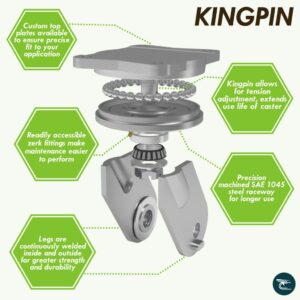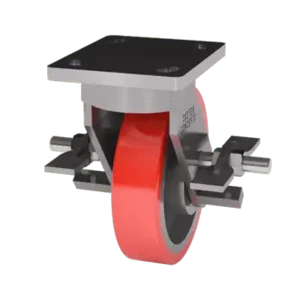Selecting an heavy duty industrial casters can feel like a maze. Where do you even begin? Let’s break down the essentials so you can pick the right dolly caster for your application with ease.
First up, figure out how much weight your heavy duty industrial casters need to support. Include both the cart and its maximum load. For a safety margin, plan for only three casters to be carrying the weight, as floors aren’t always perfectly even, meaning not all four casters may touch down at once. So, make sure three casters can handle the load.
Think about the environment and limitations of your setup. Got height or width restrictions? Go for a dual wheel caster to get top capacity without the extra height. Need a smooth ride on a rough or uneven floor? Our polyurethane treads and spring loaded casters are ready to tackle it all.
With load and application in mind, it’s time to choose the heavy duty industrial caster type. Wondering if you need spring loaded or what kind of swivel setup to go with? Here’s the breakdown:

Your choice of the wheel depends on your application’s demands:
For a more in-depth guide on selecting your caster wheel, click here. |

Add-ons give your setup the control and safety it needs:
Ready to take the next step? Dive deeper with our comprehensive guide on choosing the right caster wheel [here].
Various industries and applications use heavy duty V groove casters to facilitate smooth and controlled movement. These V groove casters … V-Groove Caster Wheels
Heavy duty spring loaded caster wheels absorb shocks and minimize cart impact, delivering smoother movement, less damage risk, and quieter … Spring Loaded Casters – Shock Absorption Wheels
At Caster Concepts, we understand the importance of minimizing noise levels in various industrial and commercial settings. That’s why we … Quiet and Noise Reducing Casters
We designed our line of maintenance free casters to reduce the force needed to turn or start rolling when the … Maintenance Free Casters
Introducing our industrial casters collection, where durability and performance are at the forefront. At Caster Concepts, we understand the demanding … Industrial Casters
When operating in industries where extreme heat is a constant factor, having the right caster wheels is crucial for ensuring … High Heat Spring Loaded/Shock Absorbing Casters
Caster Concepts design heavy duty pneumatic wheel casters to mimic car tires, offering exceptional grip and maneuverability. Essentially, manufacturers fit … Heavy Duty Pneumatic Wheel Casters
At Caster Concepts, we understand the importance of finding the right heavy duty low profile caster wheels for your specific … Heavy Duty Low Profile Casters
Heavy duty double wheel casters are essential for smooth and efficient mobility in various industrial applications. Double or dual wheeled … Heavy Duty Dual Wheel Casters
Our extensive collection features a wide range of big casters and large-diameter caster wheels designed to meet the unique needs … Heavy Duty Casters
Flanged wheel casters are constructed of premium cast iron, ductile iron, or forged steel for high strength and long wear. … Flanged Wheel Casters
We’re seeing loaded carts in facilities weighing as much as 2,000 and 3,000 lbs. The ergonomic casters used on these … Ergonomic Casters
Our heavy-duty and industrial-grade custom casters are designed to meet the unique needs of various industries. At Caster Concepts, we … Custom Casters
Our goal is to provide AGV caster wheels that can increase a company’s return on investment by increasing load capacity … AGV Casters